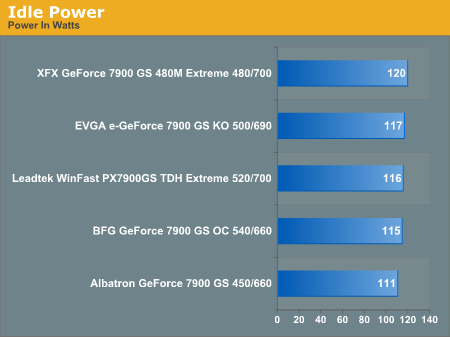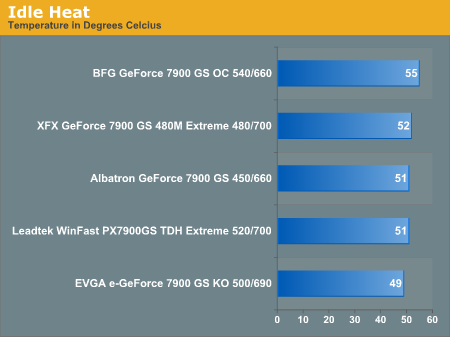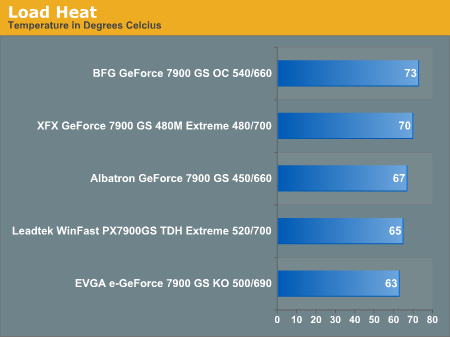The NVIDIA GeForce 7900 GS: A Closer Look
by Josh Venning on September 19, 2006 5:00 AM EST- Posted in
- GPUs
Power
Power draw is also an important factor when evaluating a graphics solution. For a card that performs or overclocks well, it can be a big drawback if the card draws a lot of extra power, especially for those running SLI setups. We test power by measuring the total wattage of the system with each card installed in two different states. The first state is while the system is idle, without any programs running, and the second state is under load, by running a graphically intensive benchmark. The benchmark we used to stress the graphics cards was 3DMark06, specifically, the fill rate (single and multi-texturing) and the pixel shader tests.


The first thing we notice here is that the XFX GeForce 7900 GS RoHS Extreme is the most power-hungry card while the system is both idle and under load. Under load, the difference is more pronounced, and the system draws about seven more watts than the card with the second highest power draw. This could be a bit of a problem for those interested in overclocking it themselves. A card with this kind of power draw will most likely get hotter and put more of a strain on your power supply while being overclocked. Conversely, the Albatron 7900 GS draws the least amount of power at both states, which makes sense considering its low clock speeds.
What is a little strange and could be seen as a plus for this card, is that the BFG 7900 GS OC, our highest-clocked 7900 GS, got the second lowest score in our power tests at both idle and load states. However, it was almost exactly tied with the Leadtek WinFast PX7900 GS TDH Extreme, which was our second-highest factory clock card. This is a bonus for both of these cards.
Heat
Similar to the way we tested power consumption, we measured the heat level of the cards in two different states: idle and after five minutes of stress testing. In order to stress test the card, we made use of ATI Tool's "Scan for Artifacts" function on their "fuzzy cube" 3D view. This feature basically works by drawing a 3D cube with some kind of fuzz map over and over and about five minutes of "scanning" with this tool gives us the same kind of heat reading we typically get from a period of extended gameplay.


Here we see that the factory overclocked BFG GeForce 7900 GS OC generates the most heat of the five, which isn't too surprising given its level of performance. Interestingly, there doesn't seem to be much correlation between power loads and heat levels for these cards, as our numbers show. The coolest-running 7900 GS we have is the EVGA e-GeForce 7900 GS KO, which might make it the 7900 GS of choice for those concerned about heat levels because of their climate or case circulation. Something notable here is that the Leadtek PX9700 GS TDH Extreme gets a fairly low heat score in our tests in spite of having one of the higher factory overclocks.
Lower temperatures can also mean better overclocking potential, which may explain the higher overclock we got with the EVGA card. Overclockers also know that adding more voltage can improve stability when overclocking - whether it be for CPUs, GPUs, or memory - and that might explain the higher power draw of the XFX card.
Power draw is also an important factor when evaluating a graphics solution. For a card that performs or overclocks well, it can be a big drawback if the card draws a lot of extra power, especially for those running SLI setups. We test power by measuring the total wattage of the system with each card installed in two different states. The first state is while the system is idle, without any programs running, and the second state is under load, by running a graphically intensive benchmark. The benchmark we used to stress the graphics cards was 3DMark06, specifically, the fill rate (single and multi-texturing) and the pixel shader tests.


The first thing we notice here is that the XFX GeForce 7900 GS RoHS Extreme is the most power-hungry card while the system is both idle and under load. Under load, the difference is more pronounced, and the system draws about seven more watts than the card with the second highest power draw. This could be a bit of a problem for those interested in overclocking it themselves. A card with this kind of power draw will most likely get hotter and put more of a strain on your power supply while being overclocked. Conversely, the Albatron 7900 GS draws the least amount of power at both states, which makes sense considering its low clock speeds.
What is a little strange and could be seen as a plus for this card, is that the BFG 7900 GS OC, our highest-clocked 7900 GS, got the second lowest score in our power tests at both idle and load states. However, it was almost exactly tied with the Leadtek WinFast PX7900 GS TDH Extreme, which was our second-highest factory clock card. This is a bonus for both of these cards.
Heat
Similar to the way we tested power consumption, we measured the heat level of the cards in two different states: idle and after five minutes of stress testing. In order to stress test the card, we made use of ATI Tool's "Scan for Artifacts" function on their "fuzzy cube" 3D view. This feature basically works by drawing a 3D cube with some kind of fuzz map over and over and about five minutes of "scanning" with this tool gives us the same kind of heat reading we typically get from a period of extended gameplay.


Here we see that the factory overclocked BFG GeForce 7900 GS OC generates the most heat of the five, which isn't too surprising given its level of performance. Interestingly, there doesn't seem to be much correlation between power loads and heat levels for these cards, as our numbers show. The coolest-running 7900 GS we have is the EVGA e-GeForce 7900 GS KO, which might make it the 7900 GS of choice for those concerned about heat levels because of their climate or case circulation. Something notable here is that the Leadtek PX9700 GS TDH Extreme gets a fairly low heat score in our tests in spite of having one of the higher factory overclocks.
Lower temperatures can also mean better overclocking potential, which may explain the higher overclock we got with the EVGA card. Overclockers also know that adding more voltage can improve stability when overclocking - whether it be for CPUs, GPUs, or memory - and that might explain the higher power draw of the XFX card.










42 Comments
View All Comments
yyrkoon - Tuesday, September 19, 2006 - link
I'd like to see how these cards compare to a 7600GT, as I currently own a eVGA 7600GT KO, and will be upgrading my current system to a conroe, and MAY consider another GFX card, especialy one this in-expencive, or maybe I'll just go the 7600GT SLI route . . .Spacecomber - Tuesday, September 19, 2006 - link
Josh probably would have done well to provide some more specific reference to the previous two Anandtech articles on the the 7900GS that Derek did, including some links to those articles, since that is where you'll find more information on how these cards compare to a wider array of video cards, including the 7600GT. However, while they tested the new 7900GS in a SLI configuration in one of those prior articles, I don't think they inclduded results from a 7600GT SLI for comparison.I'm not sure what article might have that in it for reference.
Sc4freak - Tuesday, September 19, 2006 - link
In the Oblivion test, why are do the X1800GTO and 7800GT both score 0 in the bar graph, despite their non-zero results in the line graph directly above it?Josh Venning - Tuesday, September 19, 2006 - link
Thanks for pointing this out. It's been fixed.Woodchuck2000 - Tuesday, September 19, 2006 - link
...of one of these working in SLI with a 7800GT?I'm assuming that the answer is roughly 0, but with such similar specifications, is there any hope? I've got a single 7800GT in an SLI board and can't find a second at the moment.
Re fan power consumption, you're unlikely to be looking at more than 1 watt difference across the board.
VooDooAddict - Tuesday, September 19, 2006 - link
Find someone with a 7800GT and offer them one of the 7900GS Overclocked versions in exchange.DerekWilson - Tuesday, September 19, 2006 - link
At this point, NVIDIA will not support SLI between prodcuts with different names -- even if they have the same pipeline configuration.We have mentioned that this would be quite a good incentive for people to get behind SLI, but it seems like they are worried about implying that it could work in cases where it can't.
Our suggestion is to make sli between parts that could work together an unsupported option. We haven't been able to figure out how to hack the driver to allow it, and we don't think NVIDIA will allow it.
Martrox - Tuesday, September 19, 2006 - link
Don't you think that testing these cards without any FSAA is being kind of lazy? Anyone knowledgable enough to actually read this review most likely will be using FSAA, so that kind of makes this a waste....Also, did you at least turn the drivers up to high quality?
imaheadcase - Tuesday, September 19, 2006 - link
Mmm, most people don't use FSAA. Majority of users can't tell a diffrence with it on or off.VooDooAddict - Tuesday, September 19, 2006 - link
I'd have to agree. Most people with 1280x1024 LCDs that I've met prefer to leave FSAA off (if they even mess with the setting) to get the best possible frame rates. While the max framerate might not dip below 60 ... it's the minimum framerate spike that will effect competition.I used to enjoy turning on FSAA for Everquest, but for anything more FPS competition oriented I don't know anyone who uses FSAA unless they have SLI. (Which would be why they got SLI ... to run FSAA without noticable impact to framerates.)